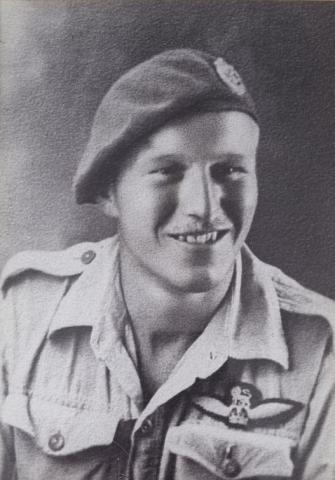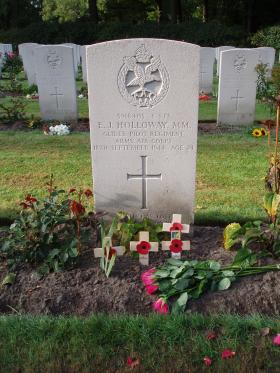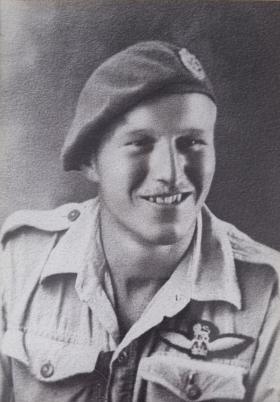Eric Holloway came from Eastleigh in Hampshire and was the son of Henry Ernest and Sarah Elizabeth Holloway. After joining the Army he later volunteered for the Glider Pilot Regiment and served with No 10 Flight, G Squadron, No 1 Wing.
He flew as second pilot with S/Sgt Mark Leaver to Holland as part of Operation Market Garden. They took off in the second lift from RAF Fairford on Monday 18 September in a Horsa (Chalk Number 1003) towed by a Short Stirling from 190 Squadron (RAF) with a cargo of five Sappers, jeep, trailer and explosives.
Mark Leaver recalled:
'Apart from light flak over various parts of Holland, the journey was fairly uneventful and we landed on the L.Z late afternoon. We then made our way to Wolfheze where we received orders to proceed to the bridge in Arnhem, via Oosterbeek and the lower road near the river.
We made good progress until we rounded a bend in Klingelbeeksweg and ran into heavy fire from the junction with Utrechtseweg where German tanks were located. We did as speedy a turn as possible with a jeep and trailer and managed to return round the bend just as the Germans spotted us and brought their heavy guns to bear.
As there was no other way available we decided to wait near the green adjacent to the Railway Station at Den Brink (now two private houses) until reinforcements arrived. After dusk we had several skirmishes with German patrols, but held our position.
At about midnight on the 18th and after hearing a lot of heavy firing coming from the other side of the railway line, we heard quite a large group of men marching along the bottom road from the direction of Oosterbeek and approaching our position. We issued a challenge, and were very relieved when it turned out to be the South Staffs. We advised them of the position and it was decided that we would continue to the bridge at first light.
Tuesday, 19th Sep. We continued towards the bridge, but made very little progress and were taking a lot of casualties. The order came to withdraw to what later became the Oosterbeek perimeter.
Eric and I occupied the rear bedroom of the second house in a row at the back of the laundry, our position facing over open land towards Arnhem. The night was quite windy and there were a lot of rustling noises which kept us on our toes. We had now been joined by a Bren gun team.
Wednesday, 20th Sep. During the morning we spotted a German squad of about 8 men setting up a mortar position about 400 yards to our left. We opened fire and cleared the site. There was no time for congratulations for where the mortar site had been there now appeared a Tiger tank which wasted no time in demolishing our position, causing us to evacuate with great speed.
We then crossed the road at the back of the laundry under cover of a phosphorous grenade. We were lucky to get across this road without casualties as a few minutes later a self propelled gun with infantry support came down the road towards the laundry. With the assistance of Major Cain and his men plus gunners from the 75mm howitzer site, this menace was suitably dealt with.
We then occupied a house at the side of the laundry and adjacent to the gun battery and in this house on the Wednesday afternoon Eric was fatally wounded. The time was early afternoon, we were up in the front bedroom with an officer from the gun battery, we were feeling a bit hungry so I volunteered to go down to the cellar at the rear of the house where there was quite a good supply of bottled fruit and vegetables. Whilst making my way with some speed down the stairs (as the front door was missing and the stairs had previously been under fire), there was a very loud explosion in the front bedroom which blew me down the last few steps. I returned through the mother of all dust storms to the front bedroom where I found the artillery officer dead [Lt Meikle, Gun Position Officer, B-Troop, 1st Airlanding Light Regiment, RA] and Eric badly peppered with shrapnel from an 88mm airburst shell from an SP gun, on the other side of the open space to our front (it had entered the bedroom through the window).
I called for medical assistance from the Artillery Battery, this came very quickly.
We got Eric to Kate Ter Horst’s house (near the Lower Church) which was now a Medical Aid Post. Eric died later that afternoon. Both Lt Meikle and Sgt Holloway were buried in the garden of the Ter Horst house.'
Eric was subsequently recommended for a posthumous Military Medal by the OC of No 1 Wing, Lt Col I A Murray, for his actions in repulsing the Self Propelled Gun. The award was confirmed in the London Gazette on 9 November 1944 and the citation for his award reads:
'During the period September 19th to 25th, Staff-Sergeant Holloway commanded a Section in a house in the area of Oosterbeek. He showed great courage in patrol work. When the enemy launched their first big attack against the gun positions he kept up effective fire with a Bren gun throughout the time the house was being demolished by a self-propelled gun at point-blank range. By remaining at his post he was largely responsible for breaking up the enemy attack. His complete disregard for his personal safety saved what might have been a serious break-through by the enemy.'
Staff Sergeant Holloway died on 20 September 1944, aged 24 years old. He is now buried at the Oosterbeek War Cemetery near Arnhem.
Profile compiled with assistance of Bob Hilton and Harvey Grenville
Read More



Latest Comments
There are currently no comments for this content.
Add Comment
In order to add comments you must be registered with ParaData.
If you are currently a ParaData member please login.
If you are not currently a ParaData member but wish to get involved please register.